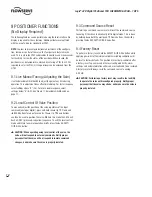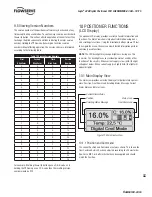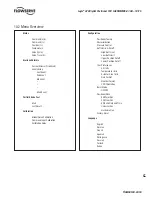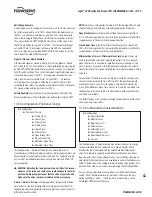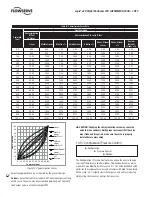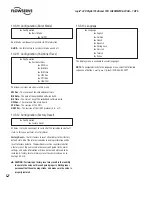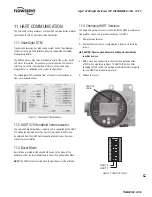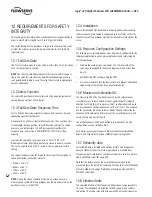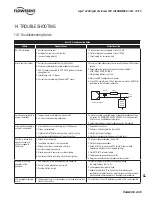
Logix
®
420 Digital Positioner FCD LGENIM0106-07-AQ – 10/15
16
generally opens less than the input command. To select one of the
other curve options, use the LCD menu, a Handheld or the ValveSight
DTM. To modify the Custom curve, use the DTM. See section 10.2.6
Configuration (Characterization) for more information.
8.3.4 Auto Tune Switch
This switch controls whether the positioner will automatically tune
itself during the stroke calibration (Quick-Cal), or use preset tuning
parameters.
On –
Selecting On enables an auto tune feature that will automatically
determine the positioner gain settings. The automatic tuning will be
based on response parameters measured during the latest Quick-Cal.
The valve response is a combination of these response parameters and
the current position of the Selectable GAIN Switch.
Off –
Selecting Off forces the positioner to use one of the factory preset
tuning sets determined by the Selectable GAIN Switch. Settings “B”
through “J” are progressively higher predefined tuning sets. Selecting
“A” on the Selectable Gain Switch during a Quick-Cal allows the user to
use and preserve manually adjusted gains.
See section 8.4 STROKE CALIBRATION for more details.
NOTE:
The gain switch is live meaning that regardless of the Auto Tune
selection, the gain settings can be adjusted at any time during operation
by changing the selectable GAIN switch position.
8.3.5 Quick Calibration Switch
This switch selects between Auto and Jog calibration modes.
Auto –
Use the Auto setting if the fully opened position of the valve has
a mechanical stop. This is typical for most valves. In Auto mode during
a stroke calibration (Quick-Cal), the positioner will fully close the valve
and register the 0% position,
Jog –
Use the Jog setting if the fully opened position of the valve has no
hard stop, but needs to be set manually. In Jog mode during a stroke
calibration (Quick-Cal), the positioner will fully close the valve and
register the 0% position, then wait for the user to move the valve to the
100% open position using the
▲
Up and
▼
Down buttons. Press the
►
ACCEPT/QUICK-CAL button to accept the 100% location.
See section 8.4 STROKE CALIBRATION for more details.
8.3.6 Valve Stability Switch
This switch adjusts the position control algorithm of the positioner for
use with low-friction control valves or high-friction automated valves.
Lo Friction –
Placing the switch to Lo Friction optimizes the response
for low friction, high performance control valves. This setting provides
for optimum response times when used with most low friction control
valves.
Hi Friction –
Placing the switch to the right optimizes the response for
valves and actuators with high friction levels. This setting slightly slows
the response and will normally stop limit cycling that can occur on
high friction valves. See section 10.2.7 CONFIGURATION (PRESSURE
CONTROL) for more details.
8.3.7 Spare Switch
If special features have been purchased they may be controlled by this
switch. See associated documentation for more details.
8.4 Stroke Calibration
The
►
ACCEPT/QUICK-CAL button is used to initiate an automatic
stroke calibration. The stroke calibration determines the closed (0%)
and open (100%) positions of the valve and gathers information
about the response of the valve (such as valve stroke time) in order to
determine the gains. The gains are then set automatically. After a stroke
calibration, the positioner is ready to control.
To perform a Quick-Cal, first ensure the Quick Calibration Switch is set
to Auto or Jog (to manually adjust the stroke limits) as appropriate.
Press and hold the
►
ACCEPT/QUICK-CAL button for approximately
3 seconds. This will initiate the automatic stroke calibration. While
the calibration is in progress, the LED lights will flash status codes
indicating the calibration progress. See section 14.3 STATUS CODE
DESCRIPTIONS for an explanation of the status code sequences.
The initial calibration of extremely large or very small actuators may
require several calibration attempts and will perform these automati-
cally. The positioner adapts to the actuator performance and begins
each calibration where the last attempt ended. On an initial installation it
is recommended that after the first successful calibration that one more
calibration be completed for optimum performance.
Figure 10: Selectable GAIN Switch
More
Responsive
More
Stable

















